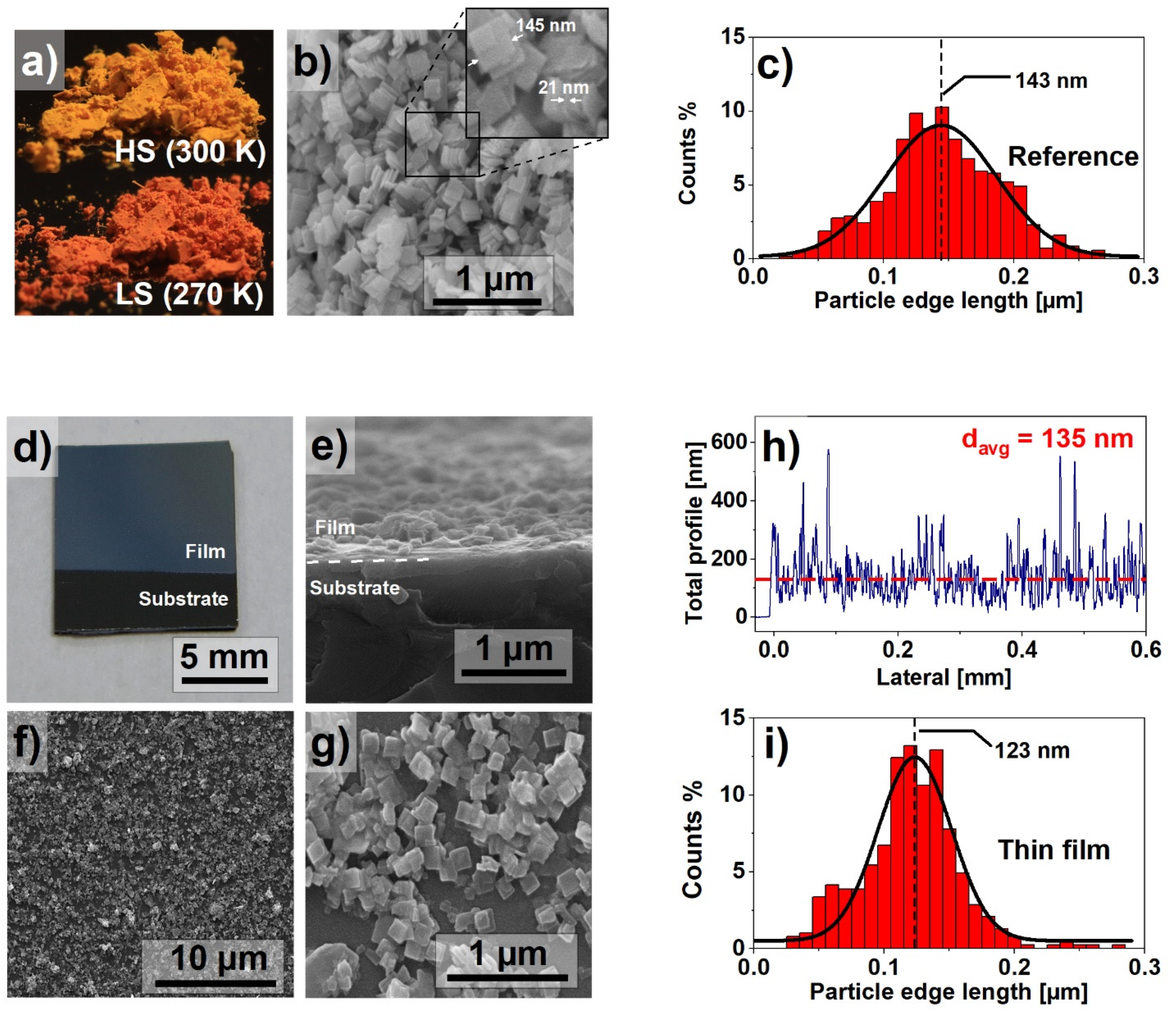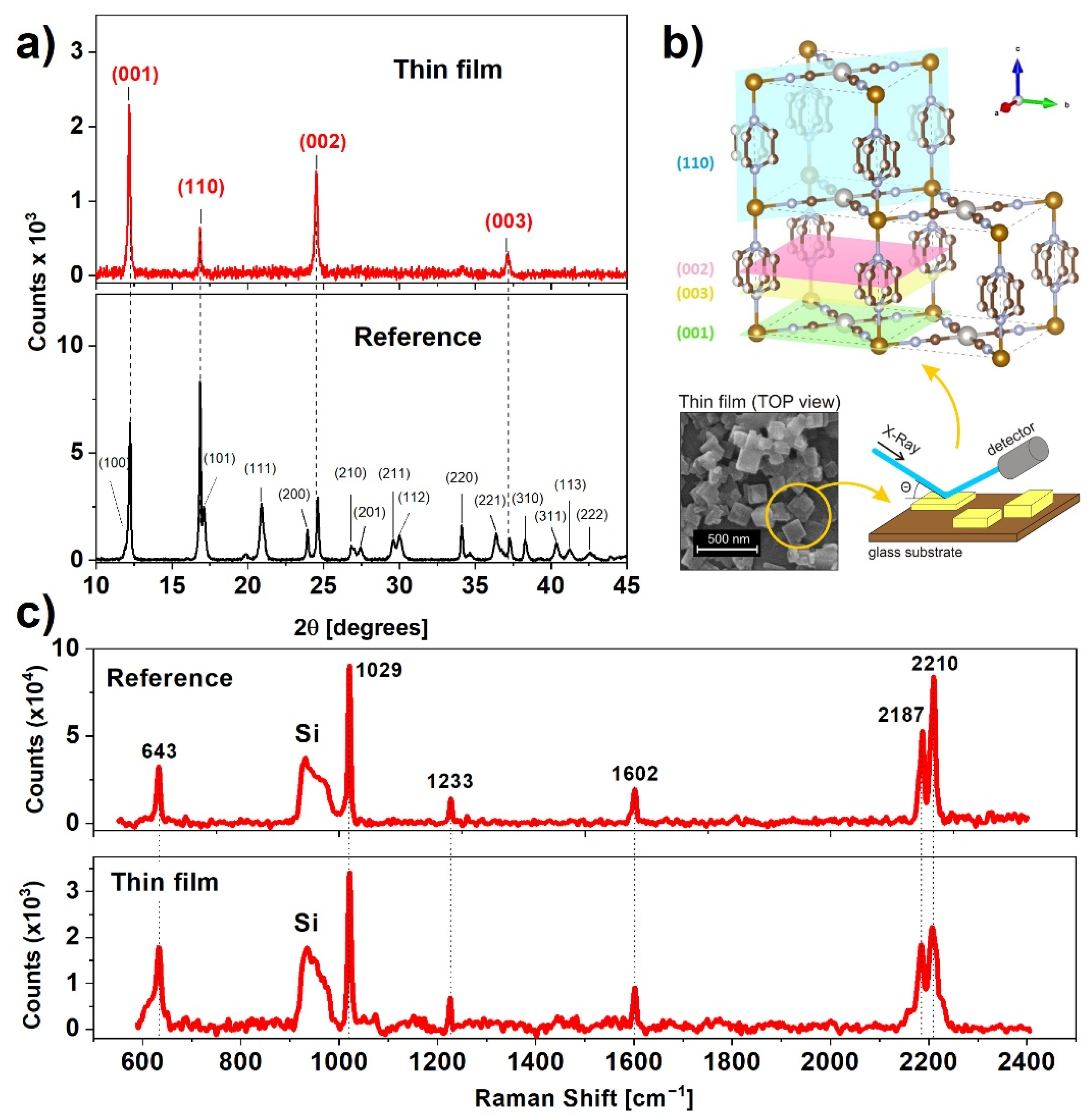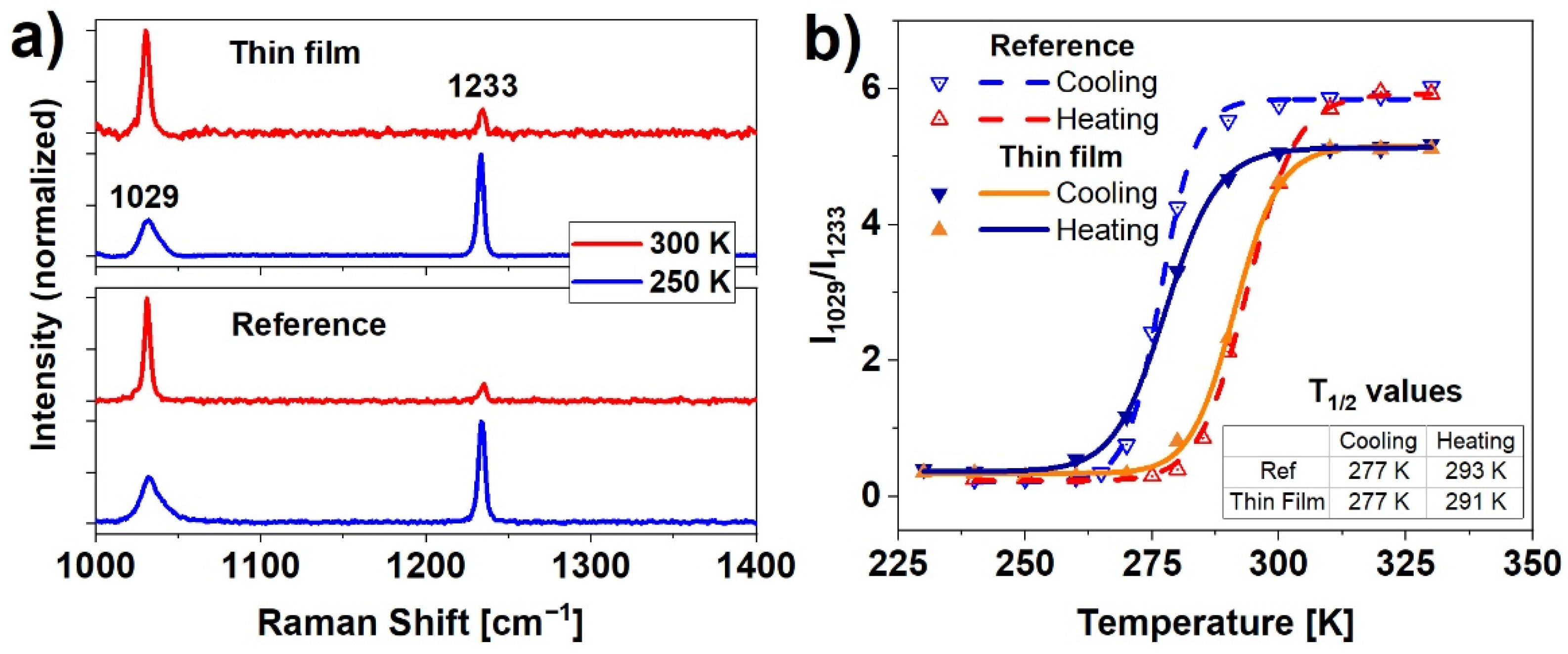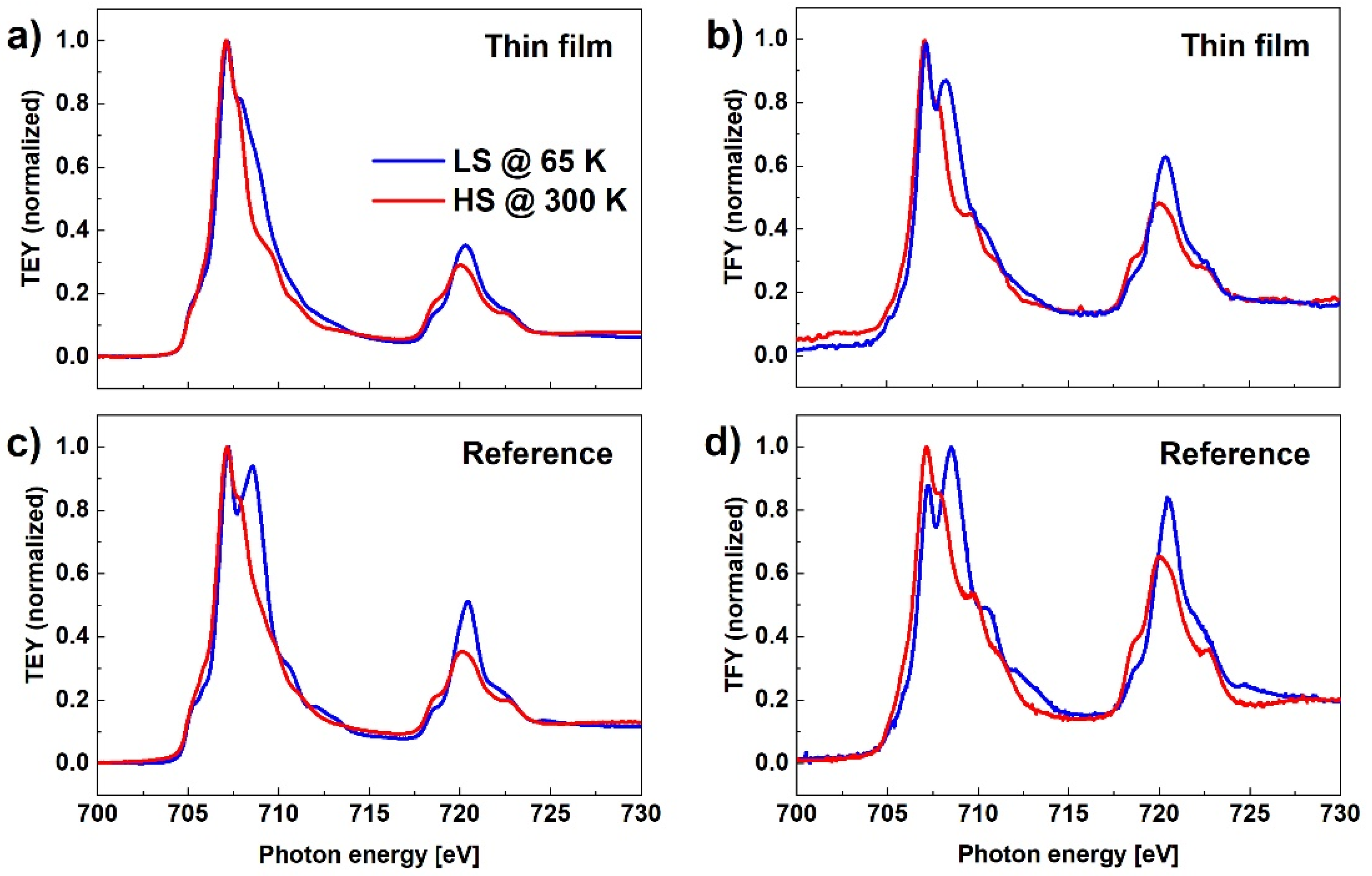Thin Films of Nanocrystalline Fe(pz)[Pt(CN)4] Deposited by Resonant Matrix-Assisted Pulsed Laser Evaporation †
Abstract
:1. Introduction
2. Materials and Methods
2.1. Fe(pz)[Pt(CN)4] Nanocrystal Preparation
2.2. Thin Film Preparation
2.3. Structural Analysis
2.4. Spin-Crossover Analysis
3. Results and Discussion
3.1. Structural Characterization
3.2. Spin-Crossover Properties
3.2.1. Temperature-Dependent Raman Measurements
3.2.2. Temperature-Dependent UV-Vis Absorption Measurements
3.2.3. X-ray Absorption Measurements
4. Conclusions
Author Contributions
Funding
Institutional Review Board Statement
Informed Consent Statement
Data Availability Statement
Acknowledgments
Conflicts of Interest
References
- Niel, V.; Martinez-Agudo, J.M.; Muñoz, M.C.; Gaspar, A.B.; Real, J.A. Cooperative spin crossover behavior in cyanide-bridged Fe(II)-M(II) bimetallic 3D Hofmann-like networks (M = Ni, Pd, and Pt). Inorg. Chem. 2001, 40, 3838–3839. [Google Scholar] [CrossRef] [PubMed]
- Cobo, S.; Ostrovskii, D.; Bonhommeau, S.; Vendier, L.; Molnár, G.; Salmon, L.; Tanaka, K.; Bousseksou, A. Single-laser-shot-induced complete bidirectional spin transition at room temperature in single crystals of (Feii(pyrazine)(Pt(CN)4)). J. Am. Chem. Soc. 2008, 130, 9019–9024. [Google Scholar] [CrossRef]
- Molnár, G.; Niel, V.; Real, J.A.; Dubrovinsky, L.; Bousseksou, A.; McGarvey, J.J. Raman spectroscopic study of pressure effects on the spin-crossover coordination polymers Fe(pyrazine)[M(CN)4]·2H2O (M = Ni, Pd, Pt). First observation of a piezo-hysteresis loop at room temperature. J. Phys. Chem. B 2003, 107, 9019–9024. [Google Scholar] [CrossRef]
- Linares, J.; Codjovi, E.; Garcia, Y. Pressure and temperature spin crossover sensors with optical detection. Sensors 2012, 12, 4479–4492. [Google Scholar] [CrossRef] [PubMed]
- Soyer, H.; Mingotaud, C.; Boillot, M.-L.; Delhaes, P. Spin crossover of a langmuir−blodgett film based on an amphiphilic iron(II) complex. Langmuir 1998, 14, 5890–5895. [Google Scholar] [CrossRef]
- Matsuda, M.; Tajima, H. Thin film of a spin crossover complex [Fe(dpp)2](BF4)2. Chem. Lett. 2007, 36, 700–701. [Google Scholar] [CrossRef]
- Kuroiwa, K.; Shibata, T.; Sasaki, S.; Ohba, M.; Takahara, A.; Kunitake, T.; Kimizuka, N. Supramolecular control of spin-crossover phenomena in lipophilic Fe(II)-1,2,4-triazole complexes. J. Polym. Sci. Part A Polym. Chem. 2006, 44, 5192–5202. [Google Scholar] [CrossRef]
- Cobo, S.; Molnár, G.; Real, J.A.; Bousseksou, A. Multilayer sequential assembly of thin films that display room-temperature spin crossover with hysteresis. Angew. Chem. Int. Ed. 2006, 45, 5786–5789. [Google Scholar] [CrossRef] [PubMed]
- Polyzou, C.D.; Tangoulis, V. Review: Downsizing effect on 2-D and 3-D spin crossover metal-organic frameworks. J. Coord. Chem. 2019, 72, 389–418. [Google Scholar] [CrossRef]
- Rubio-Giménez, V.; Bartual-Murgui, C.; Galbiati, M.; Núñez-López, A.; Castells-Gil, J.; Quinard, B.; Seneor, P.; Otero, E.; Ohresser, P.; Cantarero, A.; et al. Effect of nanostructuration on the spin crossover transition in crystalline ultrathin films. Chem. Sci. 2019, 10, 4038–4047. [Google Scholar] [CrossRef] [PubMed] [Green Version]
- Molnár, G.; Rat, S.; Salmon, L.; Nicolazzi, W.; Bousseksou, A. Spin crossover nanomaterials: From fundamental concepts to devices. Adv. Mater. 2018, 30, 1703862. [Google Scholar] [CrossRef] [PubMed]
- Sawczak, M.; Jendrzejewski, R.; Maskowicz, D.; Garcia, Y.; Ghosh, A.C.; Gazda, M.; Czechowski, J.; Śliwiński, G. Nanocrystalline polymer impregnated [Fe(pz)Pt(CN)4] thin films prepared by matrix-assisted pulsed laser evaporation. Eur. J. Inorg. Chem. 2019, 2019, 3249–3255. [Google Scholar] [CrossRef]
- Papavlu, A.P.; Dinca, V.; Filipescu, M.; Dinescu, M. Matrix-assisted pulsed laser evaporation of organic thin films: Applications in biology and chemical sensors. In Laser Ablation—From Fundamentals to Applications; Dinca, V., Ed.; IntechOpen: Rijeka, Croatia, 2017; ISBN 9789535137009. [Google Scholar]
- Icriverzi, M.; Rusen, L.; Brajnicov, S.; Bonciu, A.; Dinescu, M.; Cimpean, A.; Evans, R.W.; Dinca, V.; Roseanu, A. Macrophage in vitro response on hybrid coatings obtained by matrix assisted pulsed laser evaporation. Coatings 2019, 9, 236. [Google Scholar] [CrossRef] [Green Version]
- Piqué, A. The Matrix-Assisted Pulsed Laser Evaporation (MAPLE) process: Origins and future directions. Appl. Phys. A 2011, 105, 517–528. [Google Scholar] [CrossRef]
- Maskowicz, D.; Sawczak, M.; Jendrzejewski, R.; Gazda, M.; Tokoro, H.; Ohkoshi, S.; Garcia, Y.; Śliwiński, G. Functional phase bistability in a nanocrystalline RbMn[Fe(CN)6] thin film fabricated by matrix-assisted laser evaporation. Scr. Mater. 2020, 183, 50–54. [Google Scholar] [CrossRef]
- Maskowicz, D.; Sawczak, M.; Ghosh, A.C.; Grochowska, K.; Jendrzejewski, R.; Rotaru, A.; Garcia, Y.; Śliwiński, G. Spin crossover and cooperativity in nanocrystalline [Fe(pyrazine)Pt(CN)4] thin films deposited by matrix-assisted laser evaporation. Appl. Surf. Sci. 2021, 541, 148419. [Google Scholar] [CrossRef]
- Sawczak, M.; Jendrzejewski, R.; Maskowicz, D.; Garcia, Y.; Dîrtu, M.; Kumar, V.; Śliwiński, G. Host–guest exchange contribution to transition temperature downshift in nanocrystalline Fe(pyrazine)[Pt(CN)4] thin films prepared by matrix-assisted pulsed laser evaporation. J. Appl. Phys. 2021, 129, 155308. [Google Scholar] [CrossRef]
- Hale, G.M.; Querry, M.R. Optical Constants of Water in the 200-nm to 200-μm Wavelength Region. Appl. Opt. 1973, 12, 555–563. [Google Scholar] [CrossRef]
- Boldog, I.; Gaspar, A.B.B.; Martínez, V.; Pardo-Ibañez, P.; Ksenofontov, V.; Bhattacharjee, A.; Gütlich, P.; Real, J.A. Spin-crossover nanocrystals with magnetic, optical, and structural bistability near room temperature. Angew. Chem. Int. Ed. Engl. 2008, 47, 6433–6437. [Google Scholar] [CrossRef]
- Delgado, T.; Enachescu, C.; Tissot, A.; Guénée, L.; Hauser, A.; Besnard, C. The influence of the sample dispersion on a solid surface in the thermal spin transition of [Fe(pz)Pt(CN)4] nanoparticles. Phys. Chem. Chem. Phys. 2018, 20, 12493–12502. [Google Scholar] [CrossRef]
- Alvarado-Alvarado, D.; González-Estefan, J.H.; Flores, J.G.; Álvarez, J.R.; Aguilar-Pliego, J.; Islas-Jácome, A.; Chastanet, G.; González-Zamora, E.; Lara-García, H.A.; Alcántar-Vázquez, B.; et al. Water adsorption properties of Fe(pz)[Pt(CN)4] and the capture of CO2 and CO. Organometallics 2020, 39, 949–955. [Google Scholar] [CrossRef]
- Delgado, T.; Tissot, A.; Besnard, C.; Guénée, L.; Pattison, P.; Hauser, A. Structural investigation of the high spin→low spin relaxation dynamics of the porous coordination network [Fe(pz)Pt(CN)4]⋅2.6 H2O. Chem. A Eur. J. 2015, 21, 3664–3670. [Google Scholar] [CrossRef]
- Ohba, M.; Yoneda, K.; Agustí, G.; Muñoz, M.C.; Gaspar, A.B.; Real, J.A.; Yamasaki, M.; Ando, H.; Nakao, Y.; Sakaki, S.; et al. Bidirectional chemo-switching of spin state in a microporous framework. Angew. Chem. Int. Ed. 2009, 48, 4767–4771. [Google Scholar] [CrossRef] [PubMed]
- Bunge, H.J. Influence of texture on powder diffraction. Textures Microstruct. 1997, 29, 1–26. [Google Scholar] [CrossRef] [Green Version]
- Molnár, G.; Niel, V.; Gaspar, A.B.; Real, J.-A.; Zwick, A.; Bousseksou, A.; McGarvey, J.J. Vibrational spectroscopy of cyanide-bridged, iron(ii) spin-crossover coordination polymers: Estimation of vibrational contributions to the entropy change associated with the spin transition. J. Phys. Chem. B 2002, 106, 9701–9707. [Google Scholar] [CrossRef]
- Tuchagues, J.-P.; Bousseksou, A.; Molnár, G.; McGarvey, J.J.; Varret, F. The role of molecular vibrations in the spin crossover phenomenon. In Spin Crossover in Transition Metal Compounds III; Gütlich, P., Goodwin, H.A., Eds.; Springer: Berlin/Heidelberg, Germany, 2004; pp. 84–103. ISBN 978-3-540-44984-3. [Google Scholar]
- Levchenko, G.; Gaspar, A.B.; Bukin, G.; Berezhnaya, L.; Real, J.A. Pressure Effect Studies on the Spin Transition of Microporous 3D Polymer [Fe(pz)Pt(CN)4]. Inorg. Chem. 2018, 57, 8458–8464. [Google Scholar] [CrossRef]
- Scaltrito, D.V.; Thompson, D.W.; O’Callaghan, J.A.; Meyer, G.J. MLCT excited states of cuprous bis-phenanthroline coordination compounds. Coord. Chem. Rev. 2000, 208, 243–266. [Google Scholar] [CrossRef]
- Cartier dit Moulin, C.; Rudolf, P.; Flank, A.M.; Chen, C. Te Spin transition evidenced by soft X-ray absorption spectroscopy. J. Phys. Chem. 1992, 96, 6196–6198. [Google Scholar] [CrossRef] [Green Version]
- Mohamed, A.Y.; Lee, M.; Kitase, K.; Kitazawa, T.; Kim, J.Y.; Cho, D.Y. Soft X-ray absorption spectroscopy study of spin crossover Fe-compounds: Persistent high spin configurations under soft X-ray irradiation. Crystals 2018, 8, 433. [Google Scholar] [CrossRef] [Green Version]
- Davesne, V.; Gruber, M.; Miyamachi, T.; Da Costa, V.; Boukari, S.; Scheurer, F.; Joly, L.; Ohresser, P.; Otero, E.; Choueikani, F.; et al. First glimpse of the soft X-ray induced excited spin-state trapping effect dynamics on spin cross-over molecules. J. Chem. Phys. 2013, 139, 74708. [Google Scholar] [CrossRef] [Green Version]
- Collison, D.; David Garner, C.; McGrath, C.M.; Frederick, W.; Mosselmans, J.; Roper, M.; Seddon, M.W.; Sinn, J.E.; Young, N.A. Soft X-ray induced excited spin state trapping and soft X-ray photochemistry at the iron L2,3 edge in [Fe(phen)2(NCS)2] and [Fe(phen)2(NCSe)2] (phen = 1,10-phenanthroline). J. Chem. Soc. Dalt. Trans. 1997, 4371–4376. [Google Scholar] [CrossRef]






| Parameter | 1064 nm Laser | 3080 nm Laser |
|---|---|---|
| Ambient pressure | Near atmospheric pressure required | Deposition in vacuum available |
| Matrix | Deionized H2O | Deionized H2O |
| Interaction laser–matrix | Weak, high laser fluence required to induce ablation (>2 J/cm2) | Strong, low laser fluence required (0.8 J/cm2) |
| Interaction laser–Fe(pz)[Pt(CN)4] | Possible decomposition due to poor matrix absorption | Negligible |
| Film quality | Poor uniformity with large clusters | Good uniformity; small, sparse clusters |
| SCO temperature range compared to the reference | Significant downshift | Unchanged (near room temperature) |
Publisher’s Note: MDPI stays neutral with regard to jurisdictional claims in published maps and institutional affiliations. |
© 2021 by the authors. Licensee MDPI, Basel, Switzerland. This article is an open access article distributed under the terms and conditions of the Creative Commons Attribution (CC BY) license (https://creativecommons.org/licenses/by/4.0/).
Share and Cite
Maskowicz, D.; Jendrzejewski, R.; Kopeć, W.; Gazda, M.; Karczewski, J.; Niedziałkowski, P.; Kleibert, A.; Vaz, C.A.F.; Garcia, Y.; Sawczak, M. Thin Films of Nanocrystalline Fe(pz)[Pt(CN)4] Deposited by Resonant Matrix-Assisted Pulsed Laser Evaporation. Materials 2021, 14, 7135. https://doi.org/10.3390/ma14237135
Maskowicz D, Jendrzejewski R, Kopeć W, Gazda M, Karczewski J, Niedziałkowski P, Kleibert A, Vaz CAF, Garcia Y, Sawczak M. Thin Films of Nanocrystalline Fe(pz)[Pt(CN)4] Deposited by Resonant Matrix-Assisted Pulsed Laser Evaporation. Materials. 2021; 14(23):7135. https://doi.org/10.3390/ma14237135
Chicago/Turabian StyleMaskowicz, Dominik, Rafał Jendrzejewski, Wioletta Kopeć, Maria Gazda, Jakub Karczewski, Paweł Niedziałkowski, Armin Kleibert, Carlos A. F. Vaz, Yann Garcia, and Mirosław Sawczak. 2021. "Thin Films of Nanocrystalline Fe(pz)[Pt(CN)4] Deposited by Resonant Matrix-Assisted Pulsed Laser Evaporation" Materials 14, no. 23: 7135. https://doi.org/10.3390/ma14237135
APA StyleMaskowicz, D., Jendrzejewski, R., Kopeć, W., Gazda, M., Karczewski, J., Niedziałkowski, P., Kleibert, A., Vaz, C. A. F., Garcia, Y., & Sawczak, M. (2021). Thin Films of Nanocrystalline Fe(pz)[Pt(CN)4] Deposited by Resonant Matrix-Assisted Pulsed Laser Evaporation. Materials, 14(23), 7135. https://doi.org/10.3390/ma14237135







